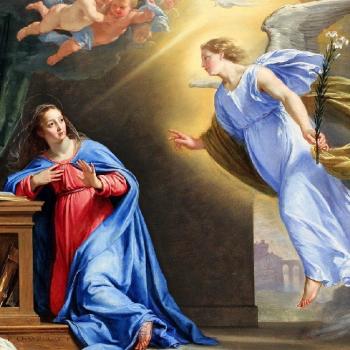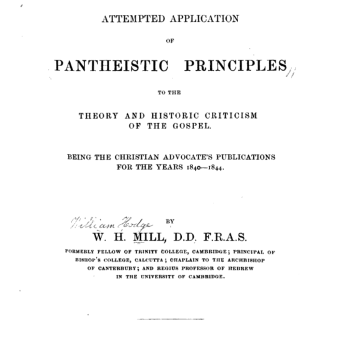Post-Tridentine Catholic theology “went so far as to develop arguments from ‘fittingness,’ . . . This “fittingness” argument is usually traced to Duns Scotus [c. 1265-1308]. Excesses such as this lent credibility to the Protestant charge that Catholics “divinized” Mary in an idolatrous way. (pp. 16-17).
Hebrews 2:10 (RSV) For it was fitting that he, for whom and by whom all things exist, in bringing many sons to glory, should make the pioneer of their salvation perfect through suffering.*Hebrews 7:26 For it was fitting that we should have such a high priest, holy, blameless, unstained, separated from sinners, exalted above the heavens.*Matthew 3:15 But Jesus answered him, “Let it be so now; for thus it is fitting for us to fulfil all righteousness.” . . .*1 Corinthians 11:13 Judge for yourselves; is it proper for a woman to pray to God with her head uncovered?*Ephesians 5:3-4 But fornication and all impurity or covetousness must not even be named among you, as is fitting among saints. [4] Let there be no filthiness, nor silly talk, nor levity, which are not fitting; but instead let there be thanksgiving.*Colossians 3:18 Wives, be subject to your husbands, as is fitting in the Lord.*2 Thessalonians 1:3 We are bound to give thanks to God always for you, brethren, as is fitting, . . .*1 Timothy 2:6 who gave himself as a ransom for all, the testimony to which was borne at the proper time.*1 Timothy 6:15 and this will be made manifest at the proper time by the blessed and only Sovereign, the King of kings and Lord of lords,*Titus 1:3 and at the proper time manifested in his word through the preaching with which I have been entrusted by command of God our Savior;
*
And indeed it was wholly fitting that so wonderful a mother should be ever resplendent with the glory of most sublime holiness and so completely free from all taint of original sin that she would triumph utterly over the ancient serpent.
*
And hence they affirmed that the Blessed Virgin was, through grace, entirely free from every stain of sin, and from all corruption of body, soul and mind; that she was always united with God and joined to him by an eternal covenant; that she was never in darkness but always in light; and that, therefore, she was entirely a fit habitation for Christ, not because of the state of her body, but because of her original grace.
For it was certainly not fitting that this vessel of election should be wounded by the common injuries, since she, differing so much from the others, had only nature in common with them, not sin. In fact, it was quite fitting that, as the Only-Begotten has a Father in heaven, whom the Seraphim extol as thrice holy, so he should have a Mother on earth who would never be without the splendor of holiness.”
After all, an angel declaring that the Blessed Virgin Mary was “full of grace” meant that she was without sin, as a straightforward deduction from the biblical data regarding grace and sin (as I have argued elsewhere). This is why it is indeed “fitting” that Mary was immaculately conceived, so that she could be freed — entirely by God’s grace, since she had no will or self-consciousness a moment after her conception –, from original as well as actual sin.
Likewise, in Munificentissimus Deus, Venerable Pope Pius XII’s declaration of the dogma of Mary’s Bodily Assumption in 1950, we find seven examples of the concept:
21. Thus St. John Damascene, an outstanding herald of this traditional truth, spoke out with powerful eloquence when he compared the bodily Assumption of the loving Mother of God with her other prerogatives and privileges. “It was fitting that she, who had kept her virginity intact in childbirth, should keep her own body free from all corruption even after death. It was fitting that she, who had carried the Creator as a child at her breast, should dwell in the divine tabernacles. It was fitting that the spouse, whom the Father had taken to himself, should live in the divine mansions. It was fitting that she, who had seen her Son upon the cross and who had thereby received into her heart the sword of sorrow which she had escaped in the act of giving birth to him, should look upon him as he sits with the Father. It was fitting that God’s Mother should possess what belongs to her Son, and that she should be honored by every creature as the Mother and as the handmaid of God.” [Encomium in Dormitionem Dei Genetricis Semperque Virginis Mariae, Hom. II, n. 14; cf. also ibid, n. 3.]*33. . . . Moreover, it is reasonable and fitting that not only the soul and body of a man, but also the soul and body of a woman should have obtained heavenly glory. Finally, since the Church has never looked for the bodily relics of the Blessed Virgin nor proposed them for the veneration of the people, we have a proof on the order of a sensible experience. [St. Bernardine of Siena, In Assumptione B. Mariae Virginis, Sermo 11.]*36. . . . there were not lacking teachers who, instead of dealing with the theological reasonings that show why it is fitting and right to believe the bodily Assumption of the Blessed Virgin Mary into heaven, . . .
*
***
***
Photo credit: The Annunciation (1644), by Philippe de Champaigne (1602-1674) [public domain / Wikimedia Commons]
***
Summary: I explain the Catholic concept of fittingness, as opposed to necessity, particularly as applicable to Mary, and prove that it is an explicitly biblical notion.














